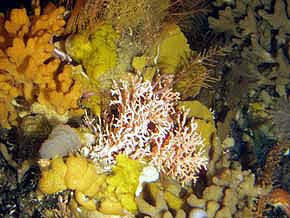 November 11, 2004
Wing and Barnard relied on their own observations, fisheries observer data, and specimens from as far back as 1905 in their five-year writing effort. The book's photos depict the corals after they've been pulled up on deck, the way fishermen and fisheries observers see them.
"This taxonomic record, building on earlier taxonomies, is not intended to be conclusive," explained Wing. "It is intended to aid observers and fishermen with the identification of coral types in the areas where they fish." The field guide is a basic tool, he said, that will increase our scientific understanding of corals, may ultimately help identify habitat areas of particular concern (HAPCs) and may help to better manage fisheries that incidentally catch deep sea Alaskan corals. The 67-page book, entitled 'A Field Guide to Alaskan Corals' (Wing, B.L., and D.R. Barnard. 2004. U.S. Dep. Commerce, NOAA Tech. Memo. NMFS-AFSC-146) will aid coral identification at the generic level. Corals are notorious for changing their shapes to adapt to a variety of environments. Conclusive identification of each species is nearly impossible without lab techniques at a microscopic level to help. "This visual taxonomy will help take some of the guesswork out of the field identification process. After a haul is loaded on deck, fishermen and observers can visually compare the corals to those in the photographic taxonomic record," Wing said. The authors have provided a form that can be used to label coral species identified out in the field. They have also provided coral collection and preservation instructions. Fishermen and fisheries observers who are uncomfortable using the key to identify corals are encouraged to keep a coral sample and send it to the Auke Bay Lab for identification. Corals are important components in the marine habitat of some juvenile commercial fish species, and are sensitive to disruption in their environment. They are also slow-growing: some scientists believe certain corals can live to be several hundred years old. Dr. Wing stated that there is much to learn about Alaskan deep sea corals. Many species have not been described in taxonomic literature. A fairly common species, Alaskagorgia aleutiana Sanchez and Cairns, was only described this year. Black corals, bamboo corals, and red tree corals all have undescribed forms which are currently being studied by specialists. Additionally, as many as a dozen other species of gorgonian corals have been collected, but not yet described. Most of these can be recognized at the genus level but not at the species level. Dr. Wing hopes that A Field Guide to Alaskan Corals will be revised and expanded within five to ten years. Intentional coral harvest is not allowed in Alaskan waters.
The guide may be viewed or printed from the Alaska Fisheries Science Center website:
A CD-ROM version of this guide is also available for $31.50 from:
Source of News Release:
|
||
